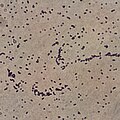Staphylococcus saprophyticus
Staphylococcus saprophyticus is a Gram-positive bacterium belonging to the genus Staphylococcus. It is a common cause of urinary tract infections (UTIs) in humans, particularly in young sexually active women. Unlike its more notorious relative, Staphylococcus aureus, S. saprophyticus is coagulase-negative, which is a key feature distinguishing it from other Staphylococcus species that are coagulase-positive.
Characteristics[edit]
Staphylococcus saprophyticus is a non-motile, facultative anaerobe that can grow in the presence or absence of oxygen. It forms white, round colonies on agar plates. This bacterium is salt-tolerant and can grow on media containing high concentrations of salt, making it part of the normal flora of the skin and genitourinary tract.
Pathogenesis[edit]
The pathogenicity of S. saprophyticus is associated with its ability to adhere to the uroepithelial cells of the urinary tract. This adherence is facilitated by the presence of adhesins on the bacterial surface. Once attached, the bacteria can colonize the urinary tract, leading to infection. S. saprophyticus is responsible for 5-20% of UTI cases, with a higher prevalence in sexually active young women.
Clinical Presentation[edit]
Infections caused by S. saprophyticus typically present as uncomplicated cystitis, with symptoms including dysuria (painful urination), increased frequency and urgency of urination, and occasionally hematuria (blood in the urine). Pyelonephritis (kidney infection) is less common but can occur, especially if the infection is not treated promptly.
Diagnosis[edit]
Diagnosis of a S. saprophyticus infection is typically made by culturing the bacterium from a urine sample. The presence of a coagulase-negative Staphylococcus species that is not S. epidermidis in a urine culture, especially in a young woman with symptoms of a UTI, is suggestive of S. saprophyticus. Identification can be confirmed through biochemical tests that differentiate it from other coagulase-negative staphylococci.
Treatment[edit]
S. saprophyticus infections are generally treated with antibiotics. The choice of antibiotic may vary based on local antibiotic resistance patterns, but commonly used antibiotics include trimethoprim-sulfamethoxazole, nitrofurantoin, and fluoroquinolones. It is important to complete the full course of antibiotics to ensure the infection is fully eradicated and to reduce the risk of developing antibiotic resistance.
Prevention[edit]
Preventive measures for S. saprophyticus UTIs include practicing good personal hygiene, urinating after sexual intercourse to flush out potential pathogens, and staying well-hydrated to promote frequent urination, which helps to clear bacteria from the urinary tract.
Epidemiology[edit]
While S. saprophyticus is a common cause of UTIs in young women, it can affect individuals of any age and sex. However, infections in men and older women are less common. The incidence of S. saprophyticus UTIs tends to increase in the late summer and early fall, though the reasons for this seasonal variation are not fully understood.
-
Staphylococcus saprophyticus resistant to Novobiocin
-
Staphylococcus saprophyticus
Ad. Transform your life with W8MD's Budget GLP-1 injections from $75


W8MD offers a medical weight loss program to lose weight in Philadelphia. Our physician-supervised medical weight loss provides:
- Weight loss injections in NYC (generic and brand names):
- Zepbound / Mounjaro, Wegovy / Ozempic, Saxenda
- Most insurances accepted or discounted self-pay rates. We will obtain insurance prior authorizations if needed.
- Generic GLP1 weight loss injections from $75 for the starting dose.
- Also offer prescription weight loss medications including Phentermine, Qsymia, Diethylpropion, Contrave etc.
NYC weight loss doctor appointmentsNYC weight loss doctor appointments
Start your NYC weight loss journey today at our NYC medical weight loss and Philadelphia medical weight loss clinics.
- Call 718-946-5500 to lose weight in NYC or for medical weight loss in Philadelphia 215-676-2334.
- Tags:NYC medical weight loss, Philadelphia lose weight Zepbound NYC, Budget GLP1 weight loss injections, Wegovy Philadelphia, Wegovy NYC, Philadelphia medical weight loss, Brookly weight loss and Wegovy NYC
|
WikiMD's Wellness Encyclopedia |
| Let Food Be Thy Medicine Medicine Thy Food - Hippocrates |
Medical Disclaimer: WikiMD is not a substitute for professional medical advice. The information on WikiMD is provided as an information resource only, may be incorrect, outdated or misleading, and is not to be used or relied on for any diagnostic or treatment purposes. Please consult your health care provider before making any healthcare decisions or for guidance about a specific medical condition. WikiMD expressly disclaims responsibility, and shall have no liability, for any damages, loss, injury, or liability whatsoever suffered as a result of your reliance on the information contained in this site. By visiting this site you agree to the foregoing terms and conditions, which may from time to time be changed or supplemented by WikiMD. If you do not agree to the foregoing terms and conditions, you should not enter or use this site. See full disclaimer.
Credits:Most images are courtesy of Wikimedia commons, and templates, categories Wikipedia, licensed under CC BY SA or similar.
Translate this page: - East Asian
中文,
日本,
한국어,
South Asian
हिन्दी,
தமிழ்,
తెలుగు,
Urdu,
ಕನ್ನಡ,
Southeast Asian
Indonesian,
Vietnamese,
Thai,
မြန်မာဘာသာ,
বাংলা
European
español,
Deutsch,
français,
Greek,
português do Brasil,
polski,
română,
русский,
Nederlands,
norsk,
svenska,
suomi,
Italian
Middle Eastern & African
عربى,
Turkish,
Persian,
Hebrew,
Afrikaans,
isiZulu,
Kiswahili,
Other
Bulgarian,
Hungarian,
Czech,
Swedish,
മലയാളം,
मराठी,
ਪੰਜਾਬੀ,
ગુજરાતી,
Portuguese,
Ukrainian



